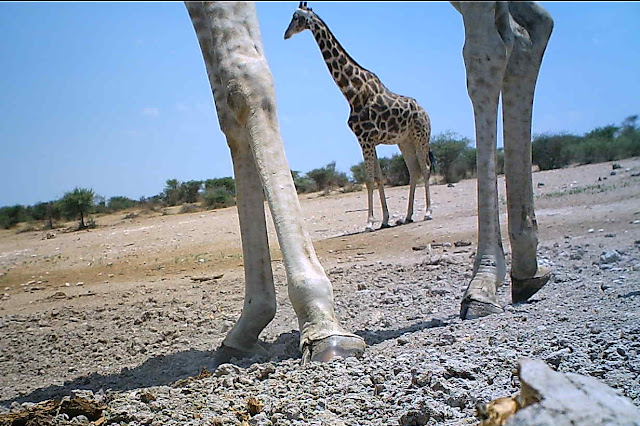I've not been well lately! My self-diagnosis leaves me in no doubt that that I have a bad case of cabin-fever. This as a result of not getting out into the wilds for about a month now. I've had to console myself with browsing through my old camera-trap images. However, while doing this I decided that I needed to pull together a post about birds - specifically those that have walked in front of my cameras.
We're extremely fortunate to have a wide variety of large raptors, as well as terrestrial species, that are quite big enough to trigger a camera at some distance. So while I've only once actually set out to get images of birds (African penguins) I do get other big fellows fairly frequently. These are some of my favourites:
Secretary Bird (Sagittarius serpentarius) at a spot where I was hoping to get an image of a leopard recently seen in the area.
Lappet-faced Vulture (Torgos tracheliotus) bullying the other birds at the water-hole.
An African Hawk-Eagle (Hieraaetus spilogaster). What was amazing about this series of images was that the other mammals in the images waited in the background for it to finish (about 20 minutes) before drinking themselves.
Marabou Stork (Leptoptilos crumeniferus)
Kori Bustard (Ardeotis kori) - apparently the worlds heaviest flying bird.
A male Ostrich (Struthio camelus) with his young.
Hadeda Ibis (Bostrychia hagedash) an extremely successful species whose range is expanding dramatically in Southern Africa.
Black-headed Heron (Ardea melanocephala).
However I can feel the fever starting to subside already since I'm headed off next week to a remarkable place called the Tankwa Karoo National Park. Its renowned for its natural beauty, rather than abundance of mammals, but I'm hopeful that the cameras will pick up something interesting.
I'll keep you posted.........
What is BushCam Adventures?
BushCam Adventures attempts to share some of the amazing images, stories and insights that I've collected during my camera-trapping adventures.
Sunday, 21 October 2012
Monday, 8 October 2012
Lovely Legs
When setting up a trailcam I usually attempt to position it about 18" off the ground. I do this for a couple of reasons:
- it usually means that you don't miss the little guys, like a mongoose, that pass close by to the camera
- a lot of wildlife photography (especially that of mammals) shows the subject level with, or slightly below, the photographer. I've got bored with this slightly 'superior' feel to wildlife photographs and so now prefer the quirky images that I get from the low angles.
What it does mean though is that I get a lot of leg shots when large mammals walk too close to the camera. Ideally, you might say, I should position the camera further away from the likely path that an animal might take. That's absolutely true but one doesn't always have too many options.
Notwithstanding the benefits of a well-framed photograph I always enjoy my leg shots. I think they often give a better 'sense of place' than would a photo of, say, an antelope's rump.
- it usually means that you don't miss the little guys, like a mongoose, that pass close by to the camera
- a lot of wildlife photography (especially that of mammals) shows the subject level with, or slightly below, the photographer. I've got bored with this slightly 'superior' feel to wildlife photographs and so now prefer the quirky images that I get from the low angles.
What it does mean though is that I get a lot of leg shots when large mammals walk too close to the camera. Ideally, you might say, I should position the camera further away from the likely path that an animal might take. That's absolutely true but one doesn't always have too many options.
Notwithstanding the benefits of a well-framed photograph I always enjoy my leg shots. I think they often give a better 'sense of place' than would a photo of, say, an antelope's rump.
Subscribe to:
Comments (Atom)















